60
When I received an invitation from the German National Tourist Board, in conjunction with the German Travel Mart (GTM), to join them in Essen, Germany I eagerly accepted.
Prior to the convention they were offering a selection of tours in nearby cities and towns to a select group of international travel journalists. I ultimately chose a tour that had me flying into Bremen, then traveling up to Bremerhaven then over to Luneburg Heath. With Germany committed to green travel, I was eager to discover what strides have been made in regards to “sustainable” travel in Northern Germany, as well as to explore the plethora of exciting museums, restaurants, protected nature reserves, and UNESCO sites.
Bremen is located in the northwest area of Germany, along the banks of the Weser River. Once there, I was game to jump on board the “green travel bandwagon,” no pun intended, and try to use only public transportation. With 10 days’ worth of luggage in hand, speaking not a word of German, and feeling jetlagged, I had to figure out where and how to use a city tram that would get me to the central train station and on to Bremerhaven.
I followed the signs to the tram and knew I had to take the one with “University” flashing as its destination. Standing on the platform, I found the ticket machine and was relieved to see an English translation, and quickly purchased my fare. As the tram approached I noticed a blond, blue-eyed Nordic looking young man carrying a violin case. We both entered the tram, smiled and sat across from each other. After an awkward silence I asked him if I was going in the right direction for the train station and he said, “Yes. Where are you from?” And I said New York. “No, you’re not, I know that slight accent.” I confessed, “Well, I grew up outside of Boston.” He laughed, “I’m from Boston!” My jaw dropped as he added, “Your stop is next, I get off there, too. I play with the symphony.”
Flowers and Windmill in Bremen (Photo by Marc Venema)
We sat in silence as I zipped open my cross-body bag searching for my business cards. Before I could find them, the tram smoothly came to a stop and just about everyone on board started pouring out as the blond virtuoso stepped off and shouted back, “Nice to meet you!” He dissolved into the sea of commuters. Good-bye Mr. Violinist from Boston, I said to myself. This encounter quelled my travel fears and set the tone for the rest of the trip, demonstrating how friendly and helpful everyone would be.
Once inside the train station I quickly realized that the ticket machines did not have an English translation button so I found the information desk. A pleasant attendant sold me my ticket and told me which track my train to Bremerhaven would arrive on. Note: Almost always, the train ticket needs to be validated, meaning slipped into a metal box up on the platform till you hear the machine stamp it. If you are caught on a train without this validation it’s a €60 euro fine.
Bremerhaven is about 40 miles north of Bremen and both cities embrace the edge of the Weser River. It’s also is the largest city on the North Sea coast of Germany. It was suggested by the GTM that I take a taxi to my hotel once the train arrives in Bremerhaven. The car was so silent, I had to ask the driver, “Is your car electric?” He nodded and I asked him if it was easy to find charging stations and he said, “Yes, very easy. I use the one at your hotel! But Google Magment. They are making a magnetized cement.”
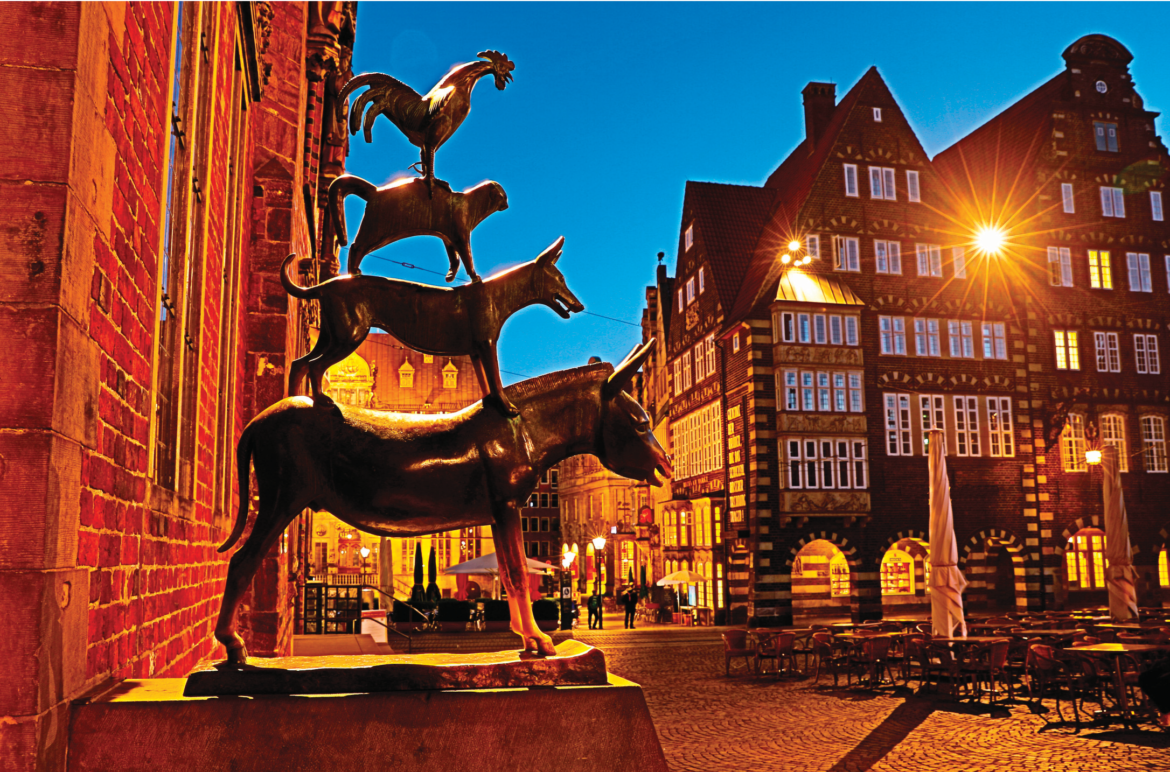

Bremen Sculpture (Photo by Czech Evgenia)
I was eager to discover what strides have been made in regards to “sustainable” travel in Northern Germany, as well as to explore the plethora of exciting museums, restaurants, protected nature reserves, and UNESCO sites.
I checked it on my smartphone, and there it was. A company called Holcim, a concrete company that has teamed up with a German start- up called Magment to create a magnetized cement that will allow electric vehicles to recharge just by driving on them.
As we drove along, I glanced out at the picturesque seaside city of Bremerhaven. There were a dozen or so cyclists enjoying a dedicated bike route along the Weser River as we passed by an accordion bus. Helping to make the city green, there are plentiful electric buses which, in Germany are spotless, comfortable, and always on time.
Located on the shores of the Weser River is the extraordinary Atlantic Hotel Sail City. At first glance it looks like a ship out at sea with its sails at full mast and billowing in the wind. It’s an illusion. A stunning architectural illusion and nod to the importance of Bremer- haven’s history with the sea.
The hotel’s green approach means they use less cleaning agents and towels. They’ve also changed out light bulbs for environmentally friendlier ones, purchased more economical devices, switched to green electricity, and air-conditioning is only turned on once a guest checks in. The Atlantic Hotel Sail City is a member of United Against Waste, an organization dedicated to exploring practical ways to reduce food waste. Along with most of the EU, they have adopted a “no single use” plastics policy, siting that most plastics end up in the sea.
You will discover that 240,000 bees have made the Atlantic Hotel rooftop their home base and produce Seaside City Honey, which is for sale in their charming gift shop. They also have a seasonally changing selection of gourmet items, souvenirs, and books which are all locally sourced that you can purchase.
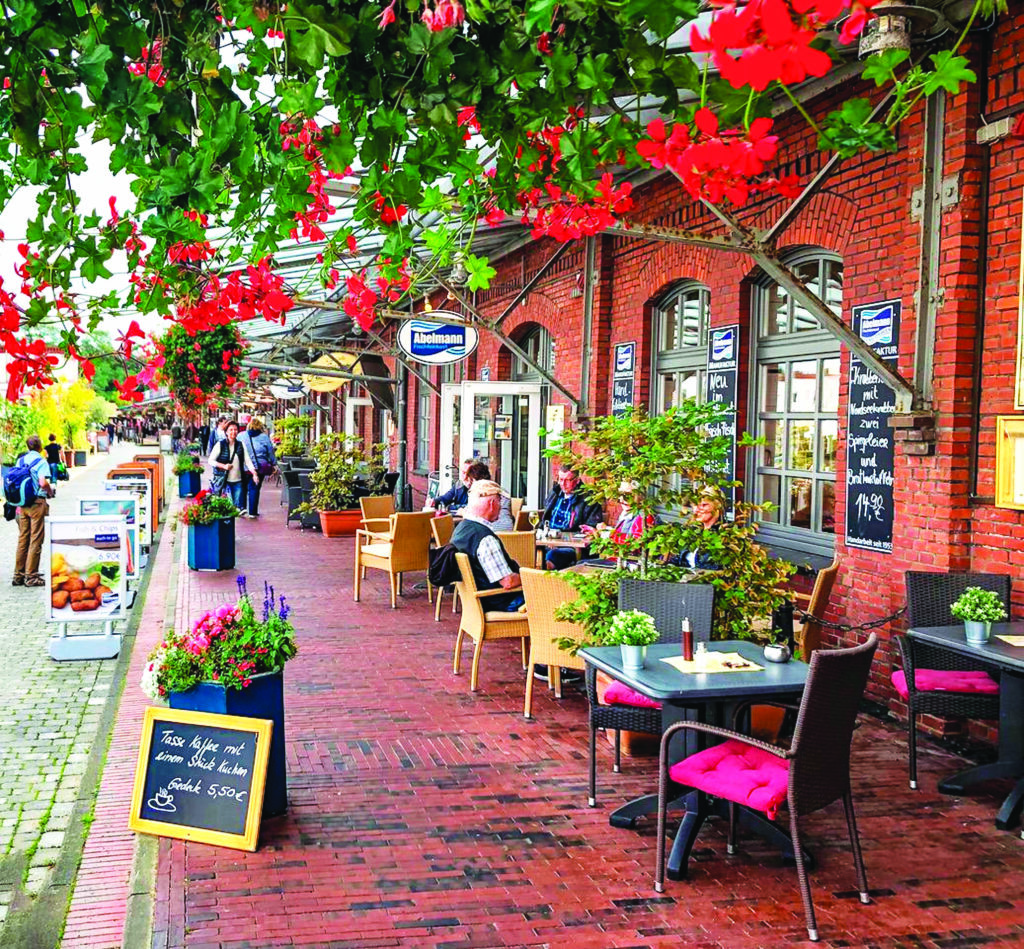

Fishery Harbor (Credit Tanja Mehl_Erlebnis)
Once settled into my room, it was a time to meet my fellow international travel journalists who were taking part in the pre-convention tour (nine of us plus three guides). After an exceptional dinner at Strom, the Atlantic Hotel’s panorama restaurant, it was a chance to get to know each other. They were a colorful group of interesting and creative colleagues from around the world: India, Croatia, Oman, Kuwait, Hungary, Italy, Norway and the two of us from the United States, Los Angeles and myself from New York City.
The next morning, after a much-needed night of deep sleep, the group of us savored the amazing spread of food presented for breakfast and then headed out to our first destination, the Schaufenster Fischereihafen fishing port.
Established in 1896, this fishing port was a huge part of Bremer- haven’s economy, and in many ways it still is. In fact, by 1938 the port was deemed the most important and powerful in all of Europe. The current location has been transforming and transitioning with the times. Even today almost 100 fish companies employing over 4000 workers process more than 200,000 tons of fish yearly. Alongside these fisheries you will discover cooking schools and learn classic recipes and tips and tricks for cooking fish as well as contemporary and exciting new dishes. You’ll also find interactive exhibitions, restaurants, and quaint gift and coffee shops. In the summer months there are music festivals as well as outdoor cinema.
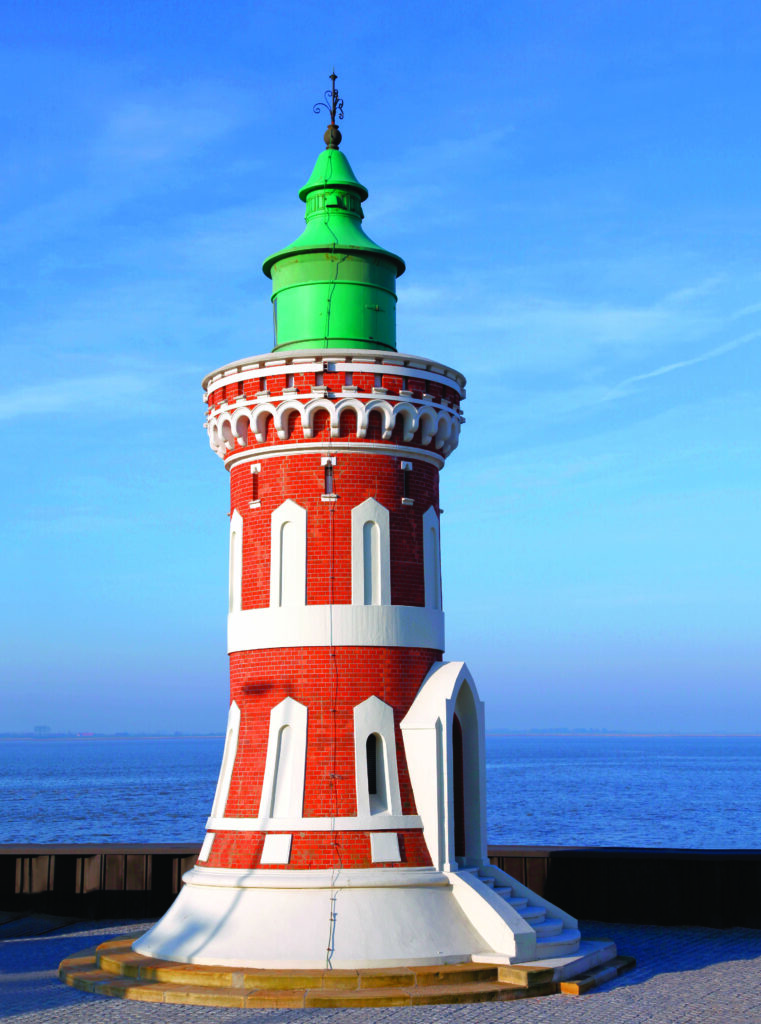

The Pingelturm Lighthouse In Bremerhaven (Photo by dedi57)
Next up on our agenda was the German Emigration Center (Deutsches Auswandererhaus), a museum dedicated to the history of German emigration. What gives this extraordinary museum an added emotional tug is that it sits on the very quay where the emigrants would have boarded their boats.
Approximately 7 million emigrants sailed from Bremerhaven to the United States as well as Argentina and Australia during the 19th and 20th centuries. Ninety percent traveled to America. The Museum has painstakingly reconstructed replicas of what the ship’s quayside would have looked like, a gang plank you can climb up to demonstrate how it felt to board the ships, what living conditions were like on the boats, what type of food they ate, and where they slept. Plus, there are extensive archives detailing the information about the people about to embark on a new life in a new world.
The museum is immersive and hands-on interactive. When you start your exploration, the museum offers you an icard, which follows a particular passenger and at different locations in the museum you can listen to their story. If you want to follow the journey of a distant relative, or even a well know successful business man such as Levi Strauss from beginning to end, there are physical and digital records to search through. They have even reconstructed locations in the Unit- ed States that emigrants might have passed through once in New York, such as mini-version of Grand Central Station
Within the museum is a wonderful café, Speisesaal. I thoroughly enjoyed a chicken curry with a coconut sauce, mango, and basmati rice. Delicious, light, and refreshing. I washed it down with Jever Pilsener. A tad bitter, it was the perfect complement to the sweetness of the coconut and mango. They also have an assortment of sweets, coffees, and teas.
Afterwards, we crossed the street and visited the Klimahaus Bremerhaven. The Klimahaus, has an exterior shaped like a boat and once inside visitors can journey around the world and explore a variety of people and environments. The aim of the museum is to stimulate your interest and curiosity regarding the subject of climate, and to motivate you to take personal measures with regard to protecting the earth. With three main areas to explore, we experienced the parched, arid desert, the overwhelming humidity of the jungle, and the bone cold reality of the freezing Antarctic. It’s also a great muse- um to bring the kids to.


Climate Museum with Atlantic Hotel in background (Photo by Francesco Carovillano)
That night, we enjoyed a stunning dinner at Pier 6. The owner, Steffen Heumann sat down with us when we first arrived at the restaurant, which is beautifully located on the harbor. Window seats in the front of the restaurant book up fast, so reservations are definitely a must.
We asked Steffen how he practices sustainability. “We work closely with nearby farms and we shop locally. Every five to six weeks we change our menu to be seasonal. We have excellent fish suppliers and we work with a nearby farmer for pork as well as duck and goose. We use the entire animal from nose to tail. It’s a lot of work for this region and it’s expensive, but the quality is good. Since the beginning of Pier 6, I have never wanted to work with suppliers that I do not know or with whom I cannot build a personal relationship. Whether it is the beverage dealer, the supplier of fruits and vegetables, the full-range grocer, or the fishmonger.”
Behind our table was Steffen’s pride and joy, a glassed-in wine cellar, stocked to the ceiling. “I’m a sommelier and it’s also my hobby. The region we’re in is Franconia and we have a fantastic wine selection and cellar.” The white wine he served was Anna-Lena Brennfleck. It was delicious: light, fruity, with a tinge of effervescence (I ordered some through my local wine store when I got back to New York).
Our menu for this very special dinner was: Salad of meadow herbs with smoke ham from their “Elmloher DUROC-Pork” (all natural) with caramelized apple served with baked pumpkin/bread- chip/pumpkin seed-dressing. It was fantastic! Even the butter served with the meal was superb. I thought I tasted a tincture of mint, but Steffen said it was just butter and white garlic.
For the main course I had their regional saddle of veal with herbs, beech mushrooms, and a potato-leek gratin. There was also a carrot crème and an asparagus ragout. Perfectly prepared to a medium-rare, the dish was elegant and lovely.
For dessert, we enjoyed a white and dark chocolate mousse with a pyramid cake, marinated berries. and sour cream; a decadent way to end a superb dinner.
The following day we traveled back down to Bremen where we met up with Michael Scheer, managing director of In the city’s center Market Square, you have the Town Hall (established in 1405), which is still the active seat of municipal as well as state government. Proudly standing before the Town Hall is the Roland statue dating back to 1404 that represents the rights and privileges of Bremen. It is the largest free-standing statue from Germany’s Middle Ages. The Town Hall and Roland are part of the UNESCO World Heritage list of protected buildings and monuments.
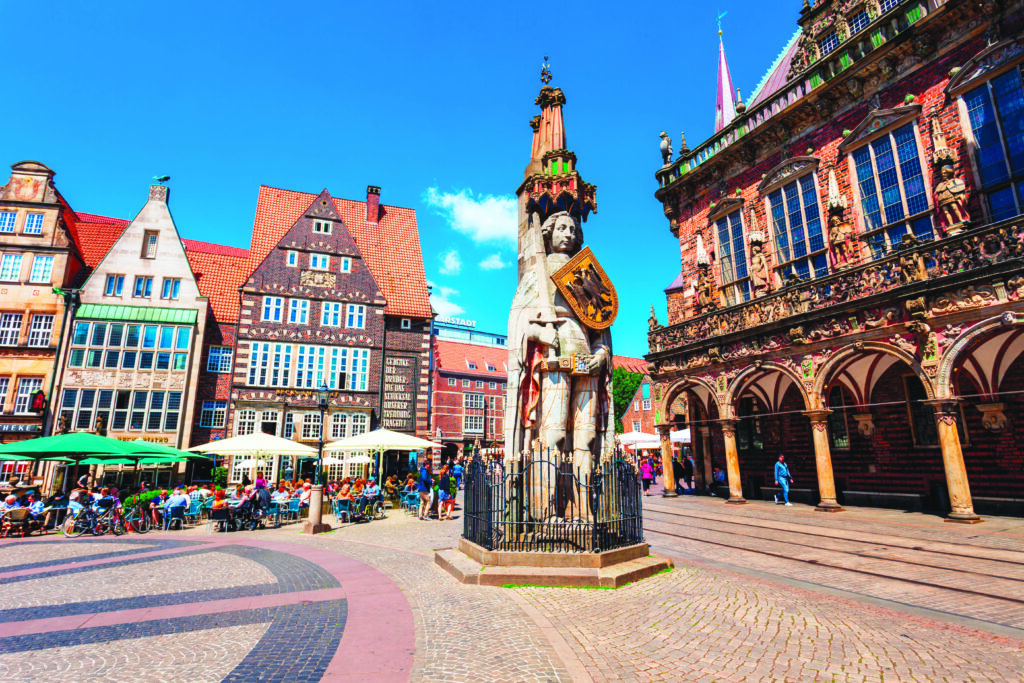

Roland Statue at the Rathausplatz in Bremen (Photo by saiko3p)
Right there in the square you will also find the statue of the Bremen Town Musicians. The towering bronze statue based upon the Grimm’s fairytale was created by Gerhard Marcks in 1953. Folklore says that if you grab the donkey’s legs and make a wish, it will come true. As you can imagine, the millions of hands that have touched his shins has turned them into shining gold.
The Market Square and the surrounding buildings had a wonderful feel, as if the town was embracing you. Just steps to the side is St. Peter’s Cathedral. Now a protestant church, it was built in 789. But for all of you biomedical Egyptologists out there, or anyone just fascinated by mummies, don’t miss seeing The Bleikeller mummies in St. Peter’s basement. There are eight in total and some date back 400 years. It’s thought that maybe the lead that was stored nearby or the dry air contributed to the mummification. Unfortunately, you are only allowed to photograph the mummies from a distance. Mummies—talk about sustainability!
If you do find yourself in the center of Bremen and need a place for a quick lunch, check out the Market Hall Eight. They have just about every cuisine in this food hall, including Indian, Mexican, Italian, Spanish, Japanese, American, and more, all at great prices.
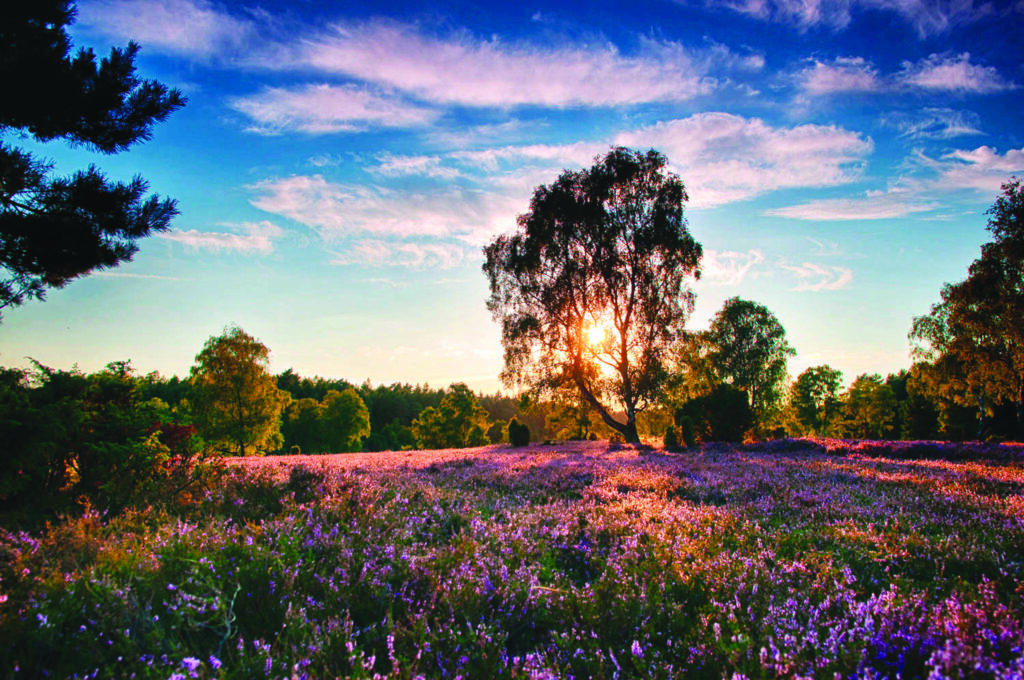

Luneburg Heath (Photo by Luneburger Heide GmbH)
Continuing our explorations, we traveled about 86 miles northeast to the Luneburg Heath Nature Reserve. An area encompassing over 57,900 acres, this national heath in lower Saxony is protected land and populated with oak, beech, and spruce trees, along with vast open fields of juniper bushes and heather. I felt right at home in this environment. My grandfather was from Glasgow, Scotland and the land- scape here had a very similar feel to the Glenmore Forest Park located in the Highlands. The air was crisp with the aroma of split wood. I think that’s because the juniper bushes grow to a tremendous size and the bush will split down its trunk and divide naturally.
We hiked for miles along the Salxstrabe, the old salt trails. This car- free zone is paradise for hiker’s, backpacker’s, birder’s, bicyclist’s, artist’s, and nature lover’s. Dotted along the route were retired vintage bee cottages that would have housed the straw beehives.
After this exhilarating walk we were happily treated to a delicious lunch at Milchhalle where I enjoyed their sheep sausage. I thought it would be a bit gamey but no, it was seasoned beautifully and tasted superb. Afterwards, we rode in a horse drawn carriage back to our starting place.
That night we checked into Hotel Camp Reinsehlen. I have to confess, of all the hotels we stayed in, this was my favorite. Hardly a camp, my room had two entire walls of glass looking out over the misty moors. Glamorous, modern, but earthy, I’d return to Camp Reinsehlen in a heartbeat to write another book or just chill out and walk the moors to recharge my batteries.
Before dinner that night, I poured myself a complimentary glass of bottled water in my room and sat out on my back porch. I listened as hard as I could, and all I could here is what I call “green noise.” There was the rustling of grass in the light breeze, and in the far distance the high-pitched rapid chirp of skylarks. Occasionally I heard the whoosh of a Red-backed Shrike flying by. I then thought to myself: ‘someone needs to bottle this.’ Afterwards, I headed over to dinner in the camp’s restaurant, Gasthaus, just a short stroll away. Thinking the restaurant was going to be rustic, I was pleasantly surprised to find it was quite elegant, as was their menu. As an appetizer we had a tuna tartar with blinis, and my main course was perfectly seared medium-rare sheep, with mashed potatoes and roasted carrots. Amazing comfort food.
The highlight of my visit came the next morning. After breakfast, as we congregated in the Camp’s main lodge, I looked out of one of the back-picture windows and I could see what looked like the horizon shifting, and then I realized it was moving towards us.
We had been told that we would meet Steffen Schmidt, a shepherd who works with his faithful dog, Fino, and his flock of 600 Heidschnucke sheep. “Look! Look!” I shouted. Everyone rushed outside and we watched as Fino, under the instructions of Steffen, flawlessly herded all 600 of the animals in our direction.
Heidschnucke sheep are extremely low maintenance and hearty. Steffen and Fino spend about 5 hours a day, allowing the flock to graze. Their fleece is naturally very strong and is excellent for making rugs. Their meat is lean and tender and considered a delicacy. And an interesting fact: both sexes of this type of sheep grow horns.
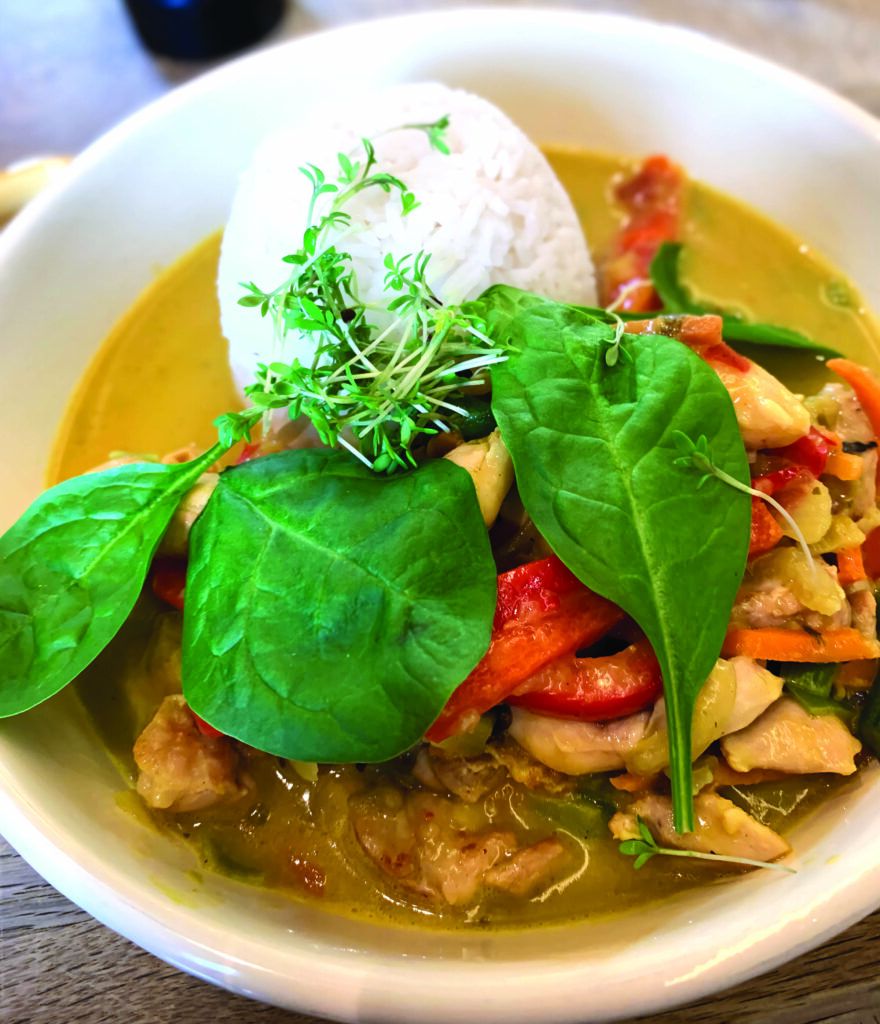

Chicken Curry at Speisesaal Restaurant (Photo by Arthur Wooten)
It’s a very dedicated person who takes on the responsibility of being a shepherd for there are no days off. Mixed in with the sheep are goats who enjoy munching on really rough brush and birch regrowth. Together they naturally keep the landscape, in particular the Luneburg Heath, trimmed and healthy. It’s called Landscape Management. Superior sustainability, I’d say. P.S.–Fino was the star of the day as the herding dog, He’s so smart, and so fast, and you could tell how much he loves his job!
Special thanks must go out to our national and local tour guides, Gabor, Ola and Dominik. Looking back, it was an amazing group of travel journalists on this trip and we bonded quickly. I thoroughly enjoyed meeting and getting to know each and every one of them, and I’m happy to know that we will remain friends.
Northern Germany Resources
ACCOMMODATIONS
BREMERHAVEN
Atlantic Hotel Sail City. Magnificent and gorgeous seaside hotel with gourmet restaurant and very green friendly. Rates from $147. (Am Strom 1. Tel: +49-471-309-900. atlantic-hotels.de).
LUNEBURG HEATH
Hotel Camp Reinsehlen. Elegant rooms set within the beauty of the Luneburg Heath National Park. Rates from $164. (Camp Rein- sehlen 1, Schneverdingen. Tel: +49-519-89830. campreinsehlen.de).
BREMEN
Monopol Boutique Hotel. Sweet and cozy and offering a delicious breakfast, the Monopol is located within walking distance of the train station. Rates from $114. (Slevogtstraße 23. Tel: +49-421-6731-9580 monopol-bremen.de).
RESTAURANTS
BREMERHAVEN
Strom. Located in the Atlantic Hotel, the Strom offers an amazing panoramic view of the Weser River and serves a wide range of elevated and sustainable dishes. It was such a simple dish, but my favorite was the crostini topped with tomatoes and herbs. Amazingly delicious. (Am Strom 1. Tel:+49-471-3099-0533. atlantic-hotels.de).
Speisesaal. A charming café in the lobby of the Emigration Museum offering seasonal, regional, and ecologically responsibly created dishes. (Columbusstraße 65. Tel: +49-471-9022-0121. dah-bremerhaven.de/speisesaal).
Pier 6. Highly recommended. Also, extremely conscious of sustainability and working with local artisans. Beautifully located on the harbor pier. Great for special events or a romantic dinner for two. (Barkhausenstraße 6. Tel: +49-471-4836-4080. pier6.de).
BREMEN
Market Hall Eight. Fantastic Food Hall at reasonable prices. Everything from Turkish to Indian to Japanese. They also offer a lot of vegan and vegetarian options. (Domshof 8-12. Tel: +49-421-989-6970. markthalleacht.de).
LUNGBURG HEATH
Milchhalle. While hiking in the nature reserve, this is a charming and welcomed rest area with a wonderful restaurant. They offer an eclectic assortment of options from homemade pea soup to their delicious bratwurst. And desserts abound. (VNP Nau- ture Park Gmbh. Tel:+49-417-580-2932. verein-naturschutzpark.de).
Gasthaus. The resident restaurant for Camp Reinsehlen. Specializing in region- al and season cuisine. Plus the restaurant offers stunning views looking out onto the moors. (Camp Reinsehlen 1. Tel: +49-519-89830. campreinsehlen.de).
MUSEUMS AND SPECIAL ATTRACTIONS
BREMERHAVEN
German Emigration Center. A remark- able immersive and interactive museum about emigration from Bremerhaven to the United States and other countries. (Columbusstraße 65. Tel: +49-471-902-200. dah-bremerhaven.de).
Klimahaus Bremerhaven. An immersive experience, the climate museum aims to encourage its visitors to think twice about cli- mate change. (Am Längengrad 8. Tel: +49-471-902-0300. klimahaus-bremerhaven.de)
Schaufenster Fischereihafen. You can shop for your daily fish, enjoy a tour of Fiedler’s Fish Market, and even take in an Chicken Curry at Speisesaal Restaurant outdoor concert at this lively fishing port. (Am Schaufenster 7. Tel: +49-471-301-0003. schaufenster-fischereihafen.de).
BREMEN
Bleikeller Mummies. Spooky as well as fascinating, eight mummies that naturally occurred beneath the knave of St. Peter’s Cathedral. (Am Dom 1. Tel: +49-421-365-040. atlasobscura.com/places/bleikeller)
Gemüsewerft. Bremen’s award-winning Urban Garden. In warmer months, the garden, located on the Weser River, is the hot spot with popular beer gardens and cafes offering a wide assortment of entertainment. (Auf der Muggenburg 18. Tel: +49-421-691-9478.)
Bremer Braumanufaktur. This brewery gets its hops from the urban garden next- door. Beer has been produced in this region for over 1,000 years! Local’s favorite is the Hapfen Fanger. (Tel: +49-176-9834-3481. bremer-braumanufaktur.de).
Town Hall and The Rolland Statue. Am Markt 21. Tel: +49-421-361-6132. The active seat of the city’s parliament, the Town Hall and the Roland statue were declared a UNESCO World Cultural Heritage site in 2004. bremen.eu

